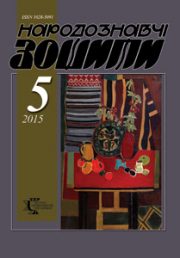The Ethnology Notebooks. 2020. № 5 (155), 1015—1021
UDK 39(477+450):001.891(091)”18/19″
DOI https://doi.org/10.15407/nz2020.05.1015
MYKHAYLYAK Tamara
- OCRID ID: http://orcid.org/0000000228879307
- PhD in Sociology and Social Research,
- Department of Social Sciences,
- University of Naples Federico II
- Vico Monte della Pietа, 1
- 80138 — Napoli, Italy,
- Contacts: е-mail: my.tamara@hotmail.it
Abstract. In this article we will try to compare the scientific practices of ethnographic investigations in Ukraine and Italy. For today’s scholars, particular interest is represented by those researches that see the European scenario and Ukrainian science as protagonists. Usually these issues are highlighted through comparative studies carried out in the Ukrainian-Polish or Ukrainian-Russian contexts, whereas European countries such as Germany, France, England are rarely seen as subjects of study.
The aim of this article is to identify and compare the similarities of ethnographic practices in Ukraine and Italy. The focus of the survey is on the systematic studies of rural dwellings and their sanitary conditions during the mid. of 19th century and the first decades of the 20th century. While it is true that Ukraine and Italy differ from each other in terms of landscape, climate and even more so in their rural housing, our study reveals that, in both countries, the application of ethnography to this specific field, shares some similarities.
The topicality of the article lies in the implementation of a comparative method, which has allowed to draw some parallels, namely the interest of scholars for the same topics, such as the correlation between the state of health of farmers and the precarious conditions of their dwellings. Furthermore, the article shows some visual sources to compare and underline the peculiarities of peasant villages in Ukraine and Italy. More precisely, the photographs of Ukrainian ethnographers like S.M. Dudin (Marcinkevyи) and M.M. Mohyljans’kyj were confronted to other shots taken by P. Scheuermeier, the Swiss scholar who had conducted his research in Italy for many years.
The results of the survey reveal that the scholars from both countries not only showed interest in the same topics, but also used the same research methods and tools especially the camera that becomes their real and powerful medium of documentation.
Keywords: Italy, Ukraine, photography, visual anthropology, peasants, rural dwellings, sanitary conditions.
Received 30.09.2020
REFERENCES
- Horlenko, V.F. (2005). History of Ukrainian ethnography (Vol. I, XII — mid. of the XIX century). Kyiv: Polihraf Konsaltinh [in Ukrainian].
- Kolessa, F.M. (2005). History of Ukrainian ethnography. Kyiv: IMFE im. M.T. Rylskoho AN Ukrainy [in Ukrainian].
- Totska, Zh. (2013). Contribution of «Commission for describing of the provinces of the Kyiv educational district» to the development of historical local lore in Chernihiv region. Severyansky chronicle, 3, 91—99 [in Ukrainian].
- Horlenko, V.F. (1965). Commission for describing of the provinces of the Kiev educational district. In Essays on the history of Russian ethnography, folklore and anthropology (Issue III, vol. 91, pp. 18—38). Moscow: AN SRSR [in Russian].
- Markevych, M.A. (1855). Population of Poltava province. In Survery of the commission, the highest established at the Imperial University of St. Volodymyr to describe the provinces of the Kyiv educational district. Kyiv [in Ukrainian].
- De la Flise, P.D. (1996—1998). Ethnographic descriptions of the peasants of the Kyiv province (1854). Kyiv [in Ukrainian].
- Nobili-Vitelleschi, F., & Fascicolo I. (1883). Provinces of Rome and Grosseto. Acts of the Board for the Agricultural Inquiry on the conditions of the agricultural class (Vol. XI). Rome: Forzani [in Italian].
- Mazzacane, L. (Ed). (1978). The «bassi» in Naples, Naples: Guida [in Italian].
- Prishchepova, V.K. (2013). To the 150th anniversary of the birth of S.M. Dudin — artist, ethnographer. In Anthropological Forum, 15, 608—649 [in Russian].
- Holovchenko, V. (2010). Mohylyanskyi Mykola Mychaylovych. In Encyclopedia of the History of Ukraine (Vol. 7, pp. 18). Kyiv: Naukova dumka [in Ukrainian].
- Frasa, M., Grassi, L., & Lurа, F. (Ed). (2008). Words in image. Paul Scheuermeier’s research in Italian Switzerland 1920—1927. Bellinzona: Centro di dialettologia e di etnografia [in Italian].
- Peter the Great Museum of Anthropology and Ethnography (the Kunstkamera). Collections online. URL: http://collection.kunstkamera.ru/ (Last accessed: 20.08.2019) [in Russian].
- Archive of Ethnography and Social History of the Lombardy Region (AESS). URL: http://www.aess.regione.lombardia.it/ (Last accessed: 20.08.2019) [in Italian].




